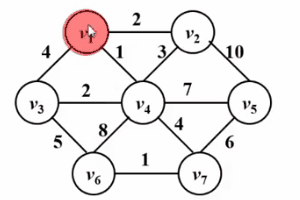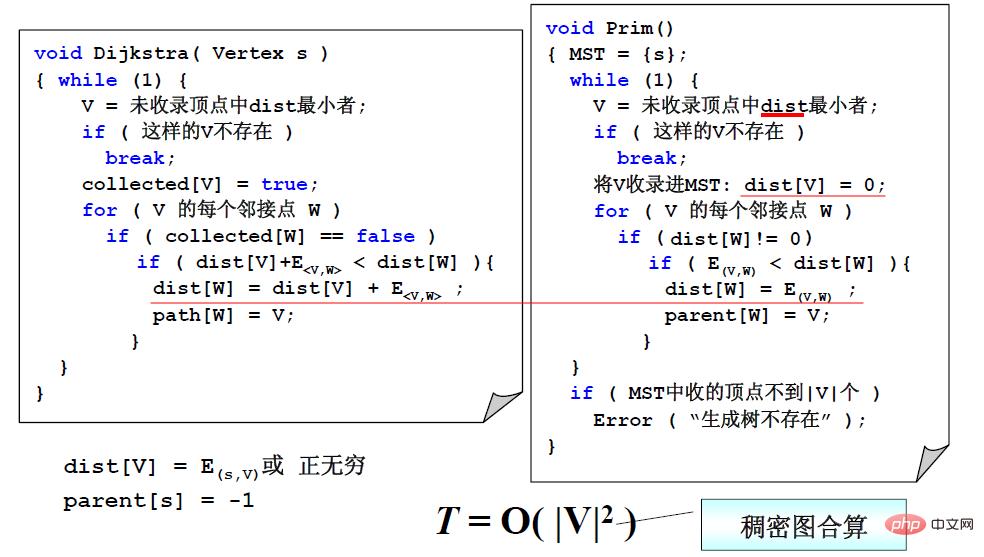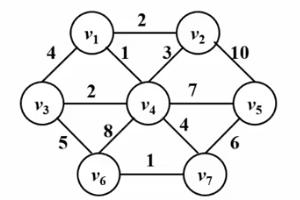Implementation of minimum spanning tree in c language

1. Introduction to Minimum Spanning Tree
What is a minimum spanning tree?
The minimum spanning tree (Minimum spanning tree, MST) is to find a tree T in a given undirected graph G(V,E), so that this tree has all the vertices in the graph G, And all edges are from edges in graph G, and satisfy the minimum sum of edge weights of the entire tree.
2.prim algorithm
is very similar to Dijkstra’s algorithm! ! Please look at the following Gif diagram. The core idea of the prim algorithm is to set a set S for the graph G (V, E), store the visited vertices, and then select the vertex with the smallest shortest distance from the set S each time from the set V-S ( Denoted as u), access and join the set S. Then, let the vertex u be the middle point, and optimize the shortest distance between all vertices v that can be reached from u and the set s. This operation is performed n times until the set s contains all vertices.

The difference is that dist in Dijkstra's algorithm is the shortest path from source point s to vertex w; while dist in prim's algorithm is from set S to vertex w The shortest path, the following is a comparison of their pseudocode descriptions. For a detailed description of the Dijkstra algorithm, please refer to the article

Algorithm implementation:
#include<iostream>
#include<vector>
#define INF 100000
#define MaxVertex 105
typedef int Vertex;
int G[MaxVertex][MaxVertex];
int parent[MaxVertex]; // 并查集
int dist[MaxVertex]; // 距离
int Nv; // 结点
int Ne; // 边
int sum; // 权重和
using namespace std;
vector<Vertex> MST; // 最小生成树
// 初始化图信息
void build(){
Vertex v1,v2;
int w;
cin>>Nv>>Ne;
for(int i=1;i<=Nv;i++){
for(int j=1;j<=Nv;j++)
G[i][j] = 0; // 初始化图
dist[i] = INF; // 初始化距离
parent[i] = -1; // 初始化并查集
}
// 初始化点
for(int i=0;i<Ne;i++){
cin>>v1>>v2>>w;
G[v1][v2] = w;
G[v2][v1] = w;
}
}
// Prim算法前的初始化
void IniPrim(Vertex s){
dist[s] = 0;
MST.push_back(s);
for(Vertex i =1;i<=Nv;i++)
if(G[s][i]){
dist[i] = G[s][i];
parent[i] = s;
}
}
// 查找未收录中dist最小的点
Vertex FindMin(){
int min = INF;
Vertex xb = -1;
for(Vertex i=1;i<=Nv;i++)
if(dist[i] && dist[i] < min){
min = dist[i];
xb = i;
}
return xb;
}
void output(){
cout<<"被收录顺序:"<<endl;
for(Vertex i=1;i<=Nv;i++)
cout<<MST[i]<<" ";
cout<<"权重和为:"<<sum<<endl;
cout<<"该生成树为:"<<endl;
for(Vertex i=1;i<=Nv;i++)
cout<<parent[i]<<" ";
}
void Prim(Vertex s){
IniPrim(s);
while(1){
Vertex v = FindMin();
if(v == -1)
break;
sum += dist[v];
dist[v] = 0;
MST.push_back(v);
for(Vertex w=1;w<=Nv;w++)
if(G[v][w] && dist[w])
if(G[v][w] < dist[w]){
dist[w] = G[v][w];
parent[w] = v;
}
}
}
int main(){
build();
Prim(1);
output();
return 0;
}About the prim algorithm For a more detailed explanation, please refer to the video https://www.bilibili.com/video/av55114968?p=99
3.kruskal algorithm
Kruskal algorithm can also be used To solve the problem of minimum spanning tree, its algorithmic idea is easy to understand. Typical edge greedy, its algorithmic idea is:
● Hide all edges in the graph in the initial state, so that each vertex in the graph It is a single connected block, and there are n connected blocks in total
● Sort all edges according to edge weight from small to large
● Test all edges according to edge weight from small to large, if If the two vertices connected by the current test edge are not in the same connected block, then the test edge is added to the current minimum spanning tree, otherwise, the edge is discarded.
● Repeat the previous step until the number of edges in the minimum spanning tree is equal to the total number of vertices minus one or it ends when all edges are tested; if at the end, the number of edges in the minimum spanning tree is less than the total number of vertices minus one 1, indicating that the graph is not connected.
Please see the Gif below!

Algorithm implementation:
#include<iostream>
#include<string>
#include<vector>
#include<queue>
#define INF 100000
#define MaxVertex 105
typedef int Vertex;
int G[MaxVertex][MaxVertex];
int parent[MaxVertex]; // 并查集最小生成树
int Nv; // 结点
int Ne; // 边
int sum; // 权重和
using namespace std;
struct Node{
Vertex v1;
Vertex v2;
int weight; // 权重
// 重载运算符成最大堆
bool operator < (const Node &a) const
{
return weight>a.weight;
}
};
vector<Node> MST; // 最小生成树
priority_queue<Node> q; // 最小堆
// 初始化图信息
void build(){
Vertex v1,v2;
int w;
cin>>Nv>>Ne;
for(int i=1;i<=Nv;i++){
for(int j=1;j<=Nv;j++)
G[i][j] = 0; // 初始化图
parent[i] = -1;
}
// 初始化点
for(int i=0;i<Ne;i++){
cin>>v1>>v2>>w;
struct Node tmpE;
tmpE.v1 = v1;
tmpE.v2 = v2;
tmpE.weight = w;
q.push(tmpE);
}
}
// 路径压缩查找
int Find(int x){
if(parent[x] < 0)
return x;
else
return parent[x] = Find(parent[x]);
}
// 按秩归并
void Union(int x1,int x2){
if(parent[x1] < parent[x2]){
parent[x1] += parent[x2];
parent[x2] = x1;
}else{
parent[x2] += parent[x1];
parent[x1] = x2;
}
}
void Kruskal(){
// 最小生成树的边不到 Nv-1 条且还有边
while(MST.size()!= Nv-1 && !q.empty()){
Node E = q.top(); // 从最小堆取出一条权重最小的边
q.pop(); // 出队这条边
if(Find(E.v1) != Find(E.v2)){ // 检测两条边是否在同一集合
sum += E.weight;
Union(E.v1,E.v2); // 并起来
MST.push_back(E);
}
}
}
void output(){
cout<<"被收录顺序:"<<endl;
for(Vertex i=0;i<Nv;i++)
cout<<MST[i].weight<<" ";
cout<<"权重和为:"<<sum<<endl;
for(Vertex i=1;i<=Nv;i++)
cout<<parent[i]<<" ";
cout<<endl;
}
int main(){
build();
Kruskal();
output();
return 0;
}For a more detailed explanation of the kruskal algorithm, please refer to the video https://www.bilibili.com/video/av55114968?p =100
Recommended course: C Language Tutorial
The above is the detailed content of Implementation of minimum spanning tree in c language. For more information, please follow other related articles on the PHP Chinese website!

Hot AI Tools

Undresser.AI Undress
AI-powered app for creating realistic nude photos

AI Clothes Remover
Online AI tool for removing clothes from photos.

Undress AI Tool
Undress images for free

Clothoff.io
AI clothes remover

Video Face Swap
Swap faces in any video effortlessly with our completely free AI face swap tool!

Hot Article

Hot Tools

Notepad++7.3.1
Easy-to-use and free code editor

SublimeText3 Chinese version
Chinese version, very easy to use

Zend Studio 13.0.1
Powerful PHP integrated development environment

Dreamweaver CS6
Visual web development tools

SublimeText3 Mac version
God-level code editing software (SublimeText3)

Hot Topics
 1392
1392
 52
52
 C language data structure: data representation and operation of trees and graphs
Apr 04, 2025 am 11:18 AM
C language data structure: data representation and operation of trees and graphs
Apr 04, 2025 am 11:18 AM
C language data structure: The data representation of the tree and graph is a hierarchical data structure consisting of nodes. Each node contains a data element and a pointer to its child nodes. The binary tree is a special type of tree. Each node has at most two child nodes. The data represents structTreeNode{intdata;structTreeNode*left;structTreeNode*right;}; Operation creates a tree traversal tree (predecision, in-order, and later order) search tree insertion node deletes node graph is a collection of data structures, where elements are vertices, and they can be connected together through edges with right or unrighted data representing neighbors.
 The truth behind the C language file operation problem
Apr 04, 2025 am 11:24 AM
The truth behind the C language file operation problem
Apr 04, 2025 am 11:24 AM
The truth about file operation problems: file opening failed: insufficient permissions, wrong paths, and file occupied. Data writing failed: the buffer is full, the file is not writable, and the disk space is insufficient. Other FAQs: slow file traversal, incorrect text file encoding, and binary file reading errors.
 C language multithreaded programming: a beginner's guide and troubleshooting
Apr 04, 2025 am 10:15 AM
C language multithreaded programming: a beginner's guide and troubleshooting
Apr 04, 2025 am 10:15 AM
C language multithreading programming guide: Creating threads: Use the pthread_create() function to specify thread ID, properties, and thread functions. Thread synchronization: Prevent data competition through mutexes, semaphores, and conditional variables. Practical case: Use multi-threading to calculate the Fibonacci number, assign tasks to multiple threads and synchronize the results. Troubleshooting: Solve problems such as program crashes, thread stop responses, and performance bottlenecks.
 How to output a countdown in C language
Apr 04, 2025 am 08:54 AM
How to output a countdown in C language
Apr 04, 2025 am 08:54 AM
How to output a countdown in C? Answer: Use loop statements. Steps: 1. Define the variable n and store the countdown number to output; 2. Use the while loop to continuously print n until n is less than 1; 3. In the loop body, print out the value of n; 4. At the end of the loop, subtract n by 1 to output the next smaller reciprocal.
 CS-Week 3
Apr 04, 2025 am 06:06 AM
CS-Week 3
Apr 04, 2025 am 06:06 AM
Algorithms are the set of instructions to solve problems, and their execution speed and memory usage vary. In programming, many algorithms are based on data search and sorting. This article will introduce several data retrieval and sorting algorithms. Linear search assumes that there is an array [20,500,10,5,100,1,50] and needs to find the number 50. The linear search algorithm checks each element in the array one by one until the target value is found or the complete array is traversed. The algorithm flowchart is as follows: The pseudo-code for linear search is as follows: Check each element: If the target value is found: Return true Return false C language implementation: #include#includeintmain(void){i
 C language data structure: the key role of data structures in artificial intelligence
Apr 04, 2025 am 10:45 AM
C language data structure: the key role of data structures in artificial intelligence
Apr 04, 2025 am 10:45 AM
C Language Data Structure: Overview of the Key Role of Data Structure in Artificial Intelligence In the field of artificial intelligence, data structures are crucial to processing large amounts of data. Data structures provide an effective way to organize and manage data, optimize algorithms and improve program efficiency. Common data structures Commonly used data structures in C language include: arrays: a set of consecutively stored data items with the same type. Structure: A data type that organizes different types of data together and gives them a name. Linked List: A linear data structure in which data items are connected together by pointers. Stack: Data structure that follows the last-in first-out (LIFO) principle. Queue: Data structure that follows the first-in first-out (FIFO) principle. Practical case: Adjacent table in graph theory is artificial intelligence
 Troubleshooting tips for processing files in C language
Apr 04, 2025 am 11:15 AM
Troubleshooting tips for processing files in C language
Apr 04, 2025 am 11:15 AM
Troubleshooting Tips for C language processing files When processing files in C language, you may encounter various problems. The following are common problems and corresponding solutions: Problem 1: Cannot open the file code: FILE*fp=fopen("myfile.txt","r");if(fp==NULL){//File opening failed} Reason: File path error File does not exist without file read permission Solution: Check the file path to ensure that the file has check file permission problem 2: File reading failed code: charbuffer[100];size_tread_bytes=fread(buffer,1,siz
 The concept of c language functions and their definition format
Apr 03, 2025 pm 11:33 PM
The concept of c language functions and their definition format
Apr 03, 2025 pm 11:33 PM
C language functions are reusable code blocks, receive parameters for processing, and return results. It is similar to the Swiss Army Knife, powerful and requires careful use. Functions include elements such as defining formats, parameters, return values, and function bodies. Advanced usage includes function pointers, recursive functions, and callback functions. Common errors are type mismatch and forgetting to declare prototypes. Debugging skills include printing variables and using a debugger. Performance optimization uses inline functions. Function design should follow the principle of single responsibility. Proficiency in C language functions can significantly improve programming efficiency and code quality.




